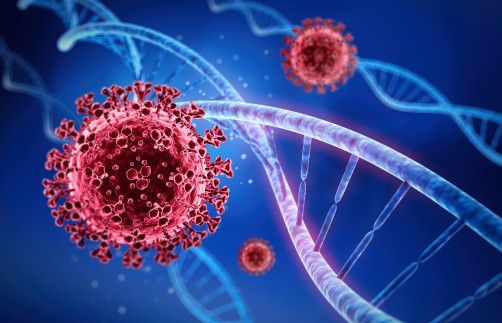Inflammasomes make up an intricate system of molecular sensors that our bodies use to sound an alarm when an infection occurs. However, the mechanisms behind these sensors, which initiate responses to threats such as invading pathogens, and how they operate has been an area of intrigue for immunologists.
In a new study, University of California San Diego biologists describe a previously unknown way that the immune system detects certain viruses. The inflammasome immune protein known as CARD8, they found, can serve as a trip wire to detect a range of viruses, including SARS-Cov-2, which causes COVID-19.
Adding a twist to their discovery, researchers led by the School of Biological Sciences’ Matt Daugherty and colleagues at the University of Washington and UC Berkeley, found that CARD8 functions differently among various species and even varies between individuals in the human population. The findings, which resulted from a series of experiments across human cell lines and an analysis of CARD8 genetic variation in mammalian species, are described in the journal PLOS Biology.
“In a version of CARD8, we found that some humans have lost the ability to sense coronavirus infections based on a single genetic difference but have gained the ability to sense viruses in a different family, the enteroviruses—which includes rhinovirus (common cold) and poliovirus,” said Daugherty, an associate professor in the Department of Molecular Biology. “So that means it’s an evolutionary tradeoff and CARD8 diversity in humans impacts which viruses can be sensed and which ones cannot.”
The research team found that the bat version of CARD8 is not able to sense coronaviruses. This could explain how coronaviruses are able to infect bats so easily and become a virus “reservoir.”
The findings provide evidence that CARD8 has evolved substantially across different species of mammals and individual humans. According to the authors, “Our findings establish CARD8 as a rapidly evolving, polymorphic, innate immune sensor of positive-sense RNA viruses.”
Daugherty said researchers have only found the tip of the iceberg in terms of the way immune sensors sound the alarm about pathogens and infection.
“It’s amazing to see this evolutionary balance of one virus to another going from sensing to not sensing—it’s mind-blowing,” said Daugherty.
More studies are needed to thoroughly determine CARD8’s role in the severity of COVID-19 infections and long COVID symptoms.
“It is tempting to speculate that diminished CARD8 inflammasome activation may be a contributing factor to variation in COVID-19 disease outcomes, and more generally for other human pathogenic coronavirus and picornavirus infections,” the authors note.
Source: University of California San Diego
